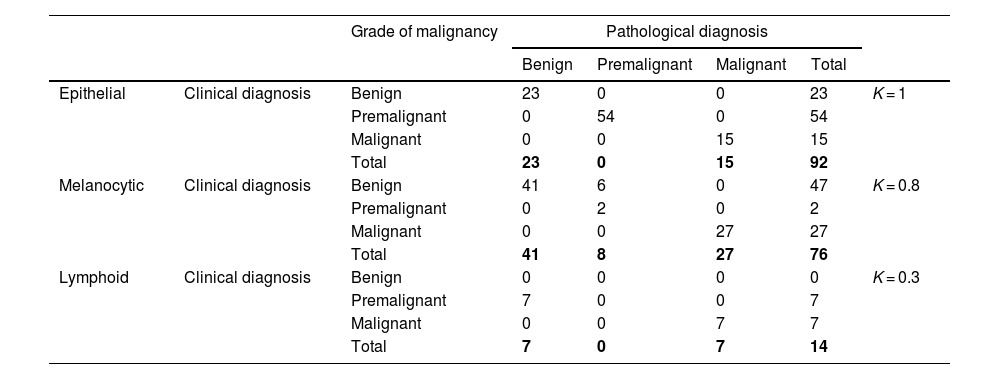The present study aims to assess the agreement between clinical and pathological diagnosis in conjunctival tumours in a specialist ocular oncology unit.
Methodsretrospective study of consecutive patients with conjunctival tumours diagnosed at the Ocular Oncology Unit of the University Hospital of Valladolid was performed from 1992 to 2017. Tumours were classified according to their origin (epithelial, melanocytic, lymphoid and others) and degree of malignancy (benign, premalignant, malignant). A biopsy was performed in cases of symptomatic or growing lesions. Cohen´s kappa (κ) statistics was used as an indicator of agreement between clinical and pathological diagnosis.
ResultsOf 462 consecutive patients, a biopsy was required in 195 (42.2%). The agreement with the pathological diagnosis was successful in 154 (79.0%) cases. Analysis according to the grade of malignancy showed the lowest rate of agreement among benign (n = 83; 91.6%) and premalignant (n = 62; 90.3%) lesions, with a total agreement in malignant lesions (n = 50; 100%); the Cohen´s kappa coefficient (κ) was 0.90. The highest rates of concordance were found in epithelial, melanocytic and soft tissue lesions with κ values of 1, 0.8 and 1 respectively. The worst rate of concordance was found in lymphoid lesions with a κ value of 0.3.
ConclusionMost of the conjunctival tumours were correctly identified clinically; benign and malignant lesions showed the highest rate of accuracy; however, premalignant tumours can hide micro-invasive diseases that can go unnoticed on clinical examination. The biopsy is essential for accurate diagnosis and treatment.
Evaluar la concordancia entre el diagnóstico clínico y patológico en tumores conjuntivales en una unidad especializada en oncología ocular.
MétodosEstudio retrospectivo de pacientes consecutivos con tumores conjuntivales diagnosticados en la Unidad de Oncología Ocular del Hospital Universitario de Valladolid desde 1992 hasta 2017. Los tumores se clasificaron según su origen (epitelial, melanocítico, linfoide y otros) y grado de malignidad (benigno, premaligno, maligno). Se realizo biopsia en los casos de lesiones sintomáticas o en crecimiento. Como indicador de concordancia entre el diagnóstico clínico y el patológico se utilizo el estadístico kappa (κ) de Cohen.
Resultados462 pacientes fueron atendidos de manera consecutiva, requiriendo biopsia en 195 (42,2%). La concordancia con el diagnóstico anatomopatológico fue satisfactoria en 154 (79,0%) casos. El análisis según el grado de malignidad mostró la menor tasa de concordancia en las lesiones benignas (n = 83; 91,6%) y premalignas (n = 62; 90,3%), con una concordancia total en las lesiones malignas (n = 50; 100%); el valor κ fue de 0,90. Los mayores índices de concordancia se encontraron en las lesiones epiteliales, melanocíticas y de partes blandas, con valores κ de 1, 0,8 y 1 respectivamente. El peor índice de concordancia se observó en lesiones linfoides, con un valor κ de 0,3.
ConclusionesLa mayoría de los tumores conjuntivales fueron correctamente identificados clínicamente. Las lesiones benignas y malignas mostraron la mayor tasa de precisión; sin embargo, las lesiones premalignas pueden ocultar enfermedad microinvasiva que puede pasar desapercibida en el examen clínico. La biopsia es esencial para un diagnóstico y un tratamiento precisos.










